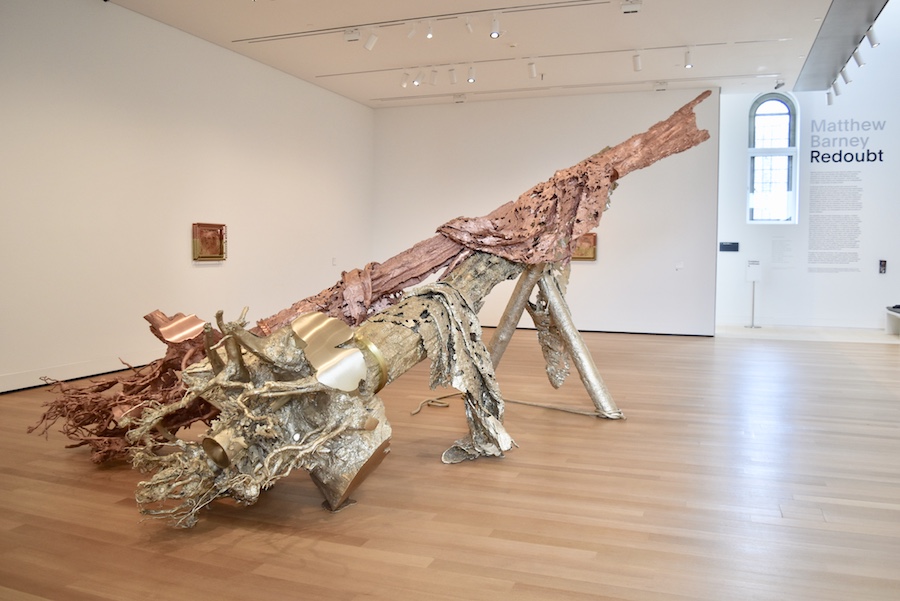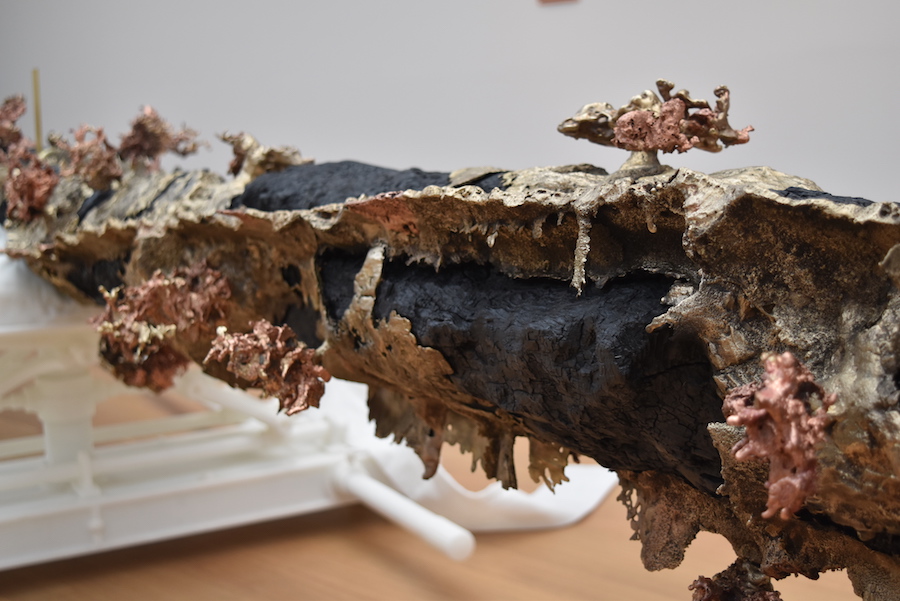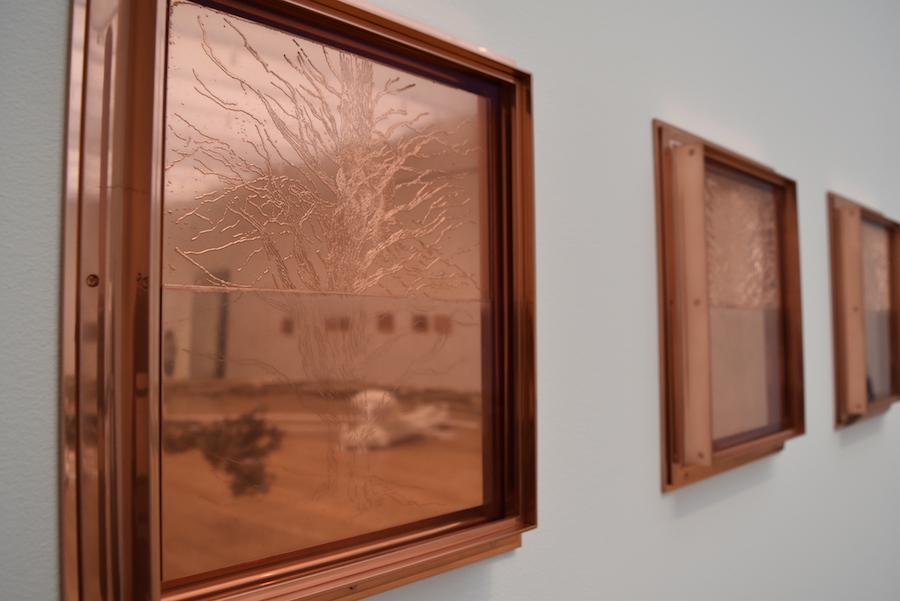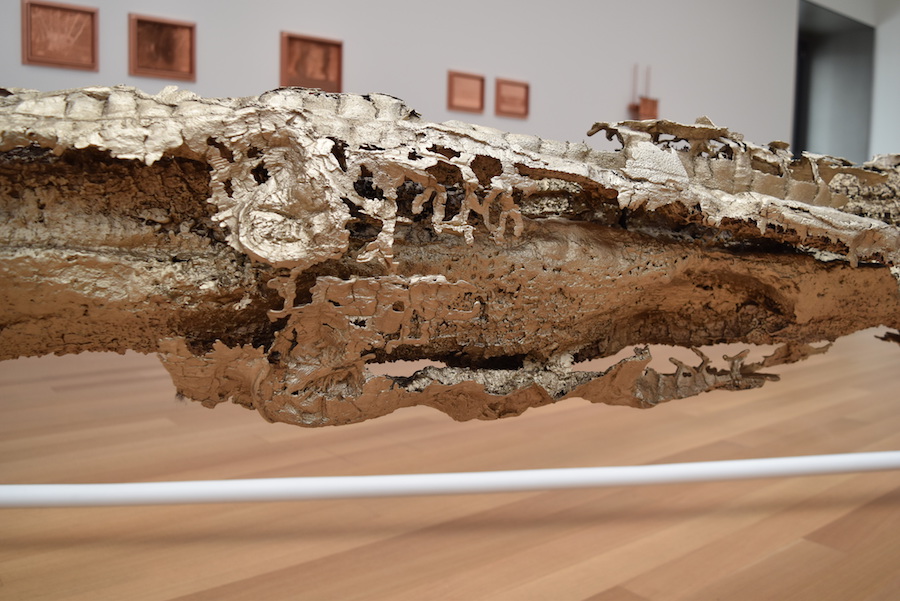

| Leah Andelsmith Photos. |
A woodland mash-up of the natural and the artificial. A modern manifestation of an ancient goddess. The spinning cosmos and the power of the moon.
Matthew Barney weaves all of these themes together in his latest exhibition, Redoubt, on view at Yale University Art Gallery through June 16. The exhibition pulls together a collection of work in various media: a feature-length film, engravings on asphalt-coated copper plates, electroplated copper plates, and large-scale sculptures in copper, bronze, and wood.
The copper engravings were created during the film by two of its characters, the artistic process becoming part of the story as the Engraver (Barney), hands off his pieces to the Electroplater, who uses a chemical and electrical process to transform the images.
In the third floor galleries, the large-scale sculptures anchor the exhibit and establish a forest setting at once familiar and strange. Three of them, Virgins, Basin Creek Burn, and Elk Creek Burn, are trees cast in bronze and copper, and the combination of the grand scale and the tiny, perfect details in the roots and the bark feel like an homage—the gilding of the forest.
Though the subject of Virgins is two fallen trees, the sculpture feels like a statue or an offering, filled respect for the wood and for the forest. The bark is sloughing off of the tree trunks but it drapes artfully, almost like a swath of fabric in a baroque painting. But the forms it adorns aren’t human: they’re arboreal. The scale of the piece brings the entire room into the artwork, the walls serving as a picture frame to complete the composition.
Other elements in Virgins send the artificial crashing through the natural. The texture of the bark is pixelated. The largest roots are sheared off and the surface that remains is polished and gleaming. The roots twist and branch like fingers, but there is a human-made form nestled among them, something smooth and torpedo shaped. It leaves the viewer wondering if this is some kind of futuristic world with cyborg trees, and places an ancient goddess firmly in the present.

Basin Creek Burn and Elk Creek Burn are set adjacent to each other: two long trunks with no branches, laid out like hospital patients or science experiments on padded stands with dangling straps. The anthropomorphizing made possible in Virgins is here too; one almost gets the feeling these trees have been labeled insane or hysterical and removed from the forest to this sterile environment.
The carvings at the ends of both pieces give the trees a militaristic feel, as if they were actually enormous rifles, or else wearing some sort of armor that would protect them from an axe. At the same time, the delicate metal work adorns the trees like jewelry.
Elk Creek Burn is a charred trunk, the burned wood clearly apparent through the brass and copper formations that decorate its length, looking like mini-volcanoes, or bonsai trees. It has an explosion of something organic at the end; if it is a gun, it’s shooting out lichen or fungus.
In the film, the scenery itself is an additional character, filling the screen with the jaw-dropping beauty of the forest-covered mountains. Those scenes of natural grandeur contrast with the human-made objects, and the humans themselves, as they play out their drama in the woods.
And Diana—Roman goddess of wild animals and the hunt, woodlands and the moon—is the center around which that action revolves.
In Redoubt, Diana is a camo-clad sharp-shooter who hunts wolves in the forest alongside her virgin attendants and protects what is hers from the meddling Engraver. In the gallery, her story is represented in a series of six images.
There is a masked Diana standing by a tree and staring into the distance, with textured clothing that is actually camouflage, but instead seems covered in feathers or scales.
A wolf approaching through the woods. A treed cougar peering down at the viewer. A mountain landscape. Two women at a bivouac.
Diana behind a gun that with the tiniest bit of imagination becomes a bow and arrow, flanked by women bending and stretching in graceful, geometric poses.

If this exhibit had a soundtrack, Tori Amos would have composed and performed it, with her evocative, angular piano that often goes from tinkling to thundering in a matter of measures. Like Amos’ music, the images are organic, but stark and strong; dark in tone but delicate and light in weight.
Each image is represented multiple times, in different stages of the electroplating process. Images in “state one” have crisp, fine lines, while images in later stages are more intense, frantic, insistent. In “state five,” the lines are saturated. Viewing them is like bearing down with a felt tip pen and watching the ink spread across the paper. Eventually the design muddles, seeping in on itself.
The longer the plates were left in their chemical bath, exposed to electrical currents, the more organic the designs appear. Blobs and rounded forms grow along the engravings and leave the copper wires looking like knobby twigs and lobster claws, like mineral deposits or coral.
The copper plates are not hung in sequence; neither the order of the images in the story nor the degree of electroplating are used as a guide. With so much separation and mixing, time is not linear in the exhibit; we’re shifting and dealing in fragments.
And yet the work feels grounded, because the same six images and five states repeat again and again. Nearby, the larger sculptural pieces keep viewers rooted in this futuristic, somewhat violent forest, the playground of this specific goddess in this specific incarnation.
Diana as a figure in this exhibit feels very fierce and independent. A skilled hunter unafraid of the woods. Wild and not controlled by society. Ruling rich and powerful places—the woodlands and the moon.
Taking this segment of the exhibit on its own, not considering the context of Barney’s oeuvre, or even the film that inspired the artwork, it feels like a centering of women’s experience. But those feminist themes start to feel merely accidental when happening upon pieces titled Cosmic Hunt: A-TACS Virgin and Cosmic Hunt: Multicam Virgin.
Then there’s the film. It juxtaposes women’s bodies and sexuality with violence, and there’s a sense that the female characters are falling into familiar tropes: muse, goddess, assistant, virgin, femme fatale. The Engraver only ever sees the Virgins clothed, and yet he depicts them naked. The nudity, both in the gallery and in the film, just feels gratuitous, like it’s taken for granted that women are going to end up naked in works of art.
“Virgin” alone is a loaded term. The fact that it is often used in mythology referring to Diana doesn’t mean it carries over automatically or lightly into the modern era. The meanings that have accumulated over time can’t be dismissed, and Barney often plays right into the tendency to lace the concept of virginity with fetishization, exploitation, and violence.

And yet there’s also a sense that these “virgins” are really just independent, choosing an existence without men and without marriage, in which they can be in total control of their lives, their choices, and their territory.
Taken as a pair, the Virgins form a trio with Diana and the Engraver, and in that way the term “virgin” is more about a phase of life. The Virgins are billed as Diana’s attendants, but it seems possible to read them (as I did) as a younger aspect of the goddess herself, more attuned with the wild woodlands than with the hunt.
Diana is a provider and protector, and is closely aligned with the wolves, her fellow hunters. The Electroplater feels like a wise woman and a mage, connected with the moon and the cosmos, and using electricity to transform the copper engravings into something organic, something more than what they were before.
Diana is the goddess of the moon, after all, and that cosmic theme winds its way through the exhibit, creating a larger scope and a grander scale. The Cosmic Hunt series features copper plates with patinas of green and red streaking across the images like comets or shooting stars, and sets of intersecting arcs that seem like they could trace the orbits of heavenly bodies. One of the plates in the Redoubt series is ink blot-like, sparking visions for me of galaxies and supernovas and nebulae—clouds of dust and gas in outer space.
In the film, the Electroplater works on her own projects while the Engraver is out in the forest, intricate sculptures made of rings that look like celestial globes or armillary spheres. Towards the end of the film, a new character, the Hoop Dancer, picks up a seemingly impossible number of hoops in an intricate formation. She traces a large circle with her dance steps and spins in place, echoing the nesting-doll pattern of spheres, revolutions and orbits in the cosmos.
In the final, climactic scene, the Electroplater dances around the trailer as it is being ransacked by wolves and as a solar eclipse reaches totality in the sky above. Like the eclipse overhead, the choreography is organized chaos, with the Electroplater executing off-kilter spins as she orbits the trailer. The eclipse itself recalls the power of the moon to blot out the sun—Diana’s cosmic hunt and her final triumph.
Tucked into a small gallery on the fourth floor, one image, Sawtooth, brings all of these themes into one frame. On the asphalt-covered plate, the engraving reveals lines of bright, sparkling copper that contrast with the dull, black surface. The face of a wolf is merged with the contours of a mountainside, its ears forming two of the peaks.
There is a fallen log in the foreground that recalls the large-scale sculptures just down the stairs. A few intersecting arcs connect the foot of the mountains to the edge of the frame, while small copper dots above a mountain range suggest stars—an echo of the cosmos.
Towards the end of the movie, when Diana finally kills her quarry, she is visibly ill and then disappears from the film. It’s as if by hunting the hunter, she kills herself as well. In Sawtooth, then, maybe the wolf is enshrined in the landscape by Diana’s hand. The effect is like a deep breath in at the end of the story: the hunter and the hunted inhabit equally important roles in the forest and each lives on beyond the kill.

